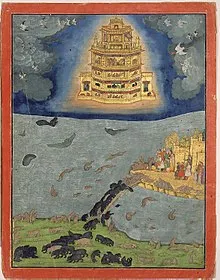Ancient Aliens May Have Found Actual Proof of Extraterrestrial Life.
Early on in the History Channel's Ancient Alien TV show, Ancient Aliens made some pretty good points and re-sparked an interest in asking that innate question: Could extraterrestrial life exist?
In 2002, the Mars Odyssey Spacecraft discovered reservoirs of ice hidden beneath Mars' surface, suggesting that life just might be able to be sustained on another planet.
Then, in 2008, the Vatican even acknowledged that life on other planets is possible and declared that it does not negate the existence of God. Long before either of those realizations occurred, Chariots of the Gods was published by Swiss author Erich von Däniken in 1968 in an attempt to prove that aliens had visited Earth thousands of years ago. Von Däniken was driven by the fact that every major religion revolves around the story of a heavenly figure visiting Earth and used this as the basis for his famous Ancient Alien Theory.
One year after it was published, Neil Armstrong walked on the moon and re-sparked America’s interest in outer space and aliens, but von Däniken’s theory that ancient Gods were alien visitors is still highly contested.

Ancient Aliens has made some pretty reasonable claims and presented a lot of facts about unexplained phenomena. While the accuracy of their scientific claims involving aliens may come into question from time to time, they certainly present some plausible explanations for otherwise unexplained events. So, was Ancient Aliens, right? Who knows - but here's a list of every time their ideas made some sense. The truth is out there, but you'll have to decide if they've found it.
- Archaeologists Have Discovered Ancient Alien Astronaut Artefacts.
- Ancient artefacts discovered all around the globe depict ancient alien astronaut technology.
Guatemala City is home to a 1,500-year-old sculpture that resembles a modern-day astronaut, complete with a helmet, a mouthpiece, and a breathing apparatus on his chest. Meanwhile, in Columbia, thousands of tomb artefacts recovered that all resemble modern-day aeroplanes, complete with fixed wings, an upright tail-fin, and a fuselage
Finally, in the Istanbul Museum, there’s a sculpture of a headless astronaut in a space suit sitting inside a rocket ship covered in tubes. Where did these cultures get such advanced ideas about aerodynamics? Ancient Alien theorists believe that these are all examples of cultures documenting visits from extraterrestrials.
Many Religions Have Stories Of Flying Machines Descending From The Heavens.

The Sanskrit word vi-māna (विमान) means measuring out, traversing, or having been measured out. Monier Monier-Williams defines Vimana as a car or a chariot of the gods, any self-moving aerial car sometimes serving as a seat or throne, sometimes self-moving and carrying its occupant through the air; other descriptions make the Vimana more like a house or palace, and one kind is said to be seven stories high, and quotes the Pushpaka Vimana of Ravana as an example. It may denote any car or vehicle, especially a bier or a ship, as well as a palace of an emperor, especially with seven stories. In some modern Indian languages like Malayalam, Telugu, Hindi, vimana or vimana means "aircraft", for example in the town named Vimanapura (a suburb of Bangalore) and Vimannagar, a town in Pune. In another context, Vimana is a feature of Hindu temple architecture.

The predecessors of the flying vimanas of the Sanskrit epics are the flying chariots employed by various gods in the Vedas: the Sun (see Sun chariot) and Indra and several other Vedic deities are transported by flying wheeled chariots pulled by animals, usually horses. The existing Rigveda versions do not mention Vimanas, but verses RV 1.164.47-48 have been taken as evidence for the idea of "mechanical birds.""
kṛṣṇáṃ niyânaṃ hárayaḥ suparṇâ / apó vásānā dívam út patanti tá âvavṛtran sádanād ṛtásyâd / íd ghṛténa pṛthivî vy ùdyate 48. dvâdaśa pradháyaś cakrám ékaṃ / trîṇi nábhyāni ká u tác ciketa tásmin sākáṃ triśatâ ná śaṅkávo / 'rpitâḥ ṣaṣṭír ná calācalâsaḥ.
Dark the descent: the birds are golden-coloured; up to the heaven, they fly robed in the waters. Again descend they from the seat of Order, and all the earth is moistened with their fatness. Twelve are the fellies, and the wheel is single; three are the naves. What man hath understood it? Therein are set together spokes three hundred and sixty, which in nowise can be loosened. (Griffith)
Swami Dayananda Saraswati interpreted these verses to mean: jumping into space speedily with a craft using fire and water containing twelve sanghas (pillars), one wheel, three machines, pivots, and 60 instruments.
In the Ramayana, the pushpaka (flowery) vimana of Ravana is described as follows: The Pushpaka Vimana that resembles the Sun and belongs to my brother was brought by the powerful Ravana; that aerial and excellent Vimana going everywhere at will. that chariot resembling a bright cloud in the sky and the King Rama got in, and the excellent chariot at the command of the Raghira rose into the higher atmosphere. It is the first flying vimana mentioned in existing Hindu texts (as distinct from the gods' flying horse-drawn chariots). Pushpaka was originally made by Vishwakarma for Brahma, the Hindu god of creation; later Brahma gave it to Kubera, the God of wealth; but it was later stolen, along with Lanka, by his half-brother, King Ravana.
Link to our source of information.

Jeg er bare helt overbevist om at der har været nogen her på Jorden før os - og ligeledes at vi har haft besøg fra en anden Verden --- Måske får vi det igen. Men om vi skal ønske os det. er jeg ikke sikker på.
ReplyDelete